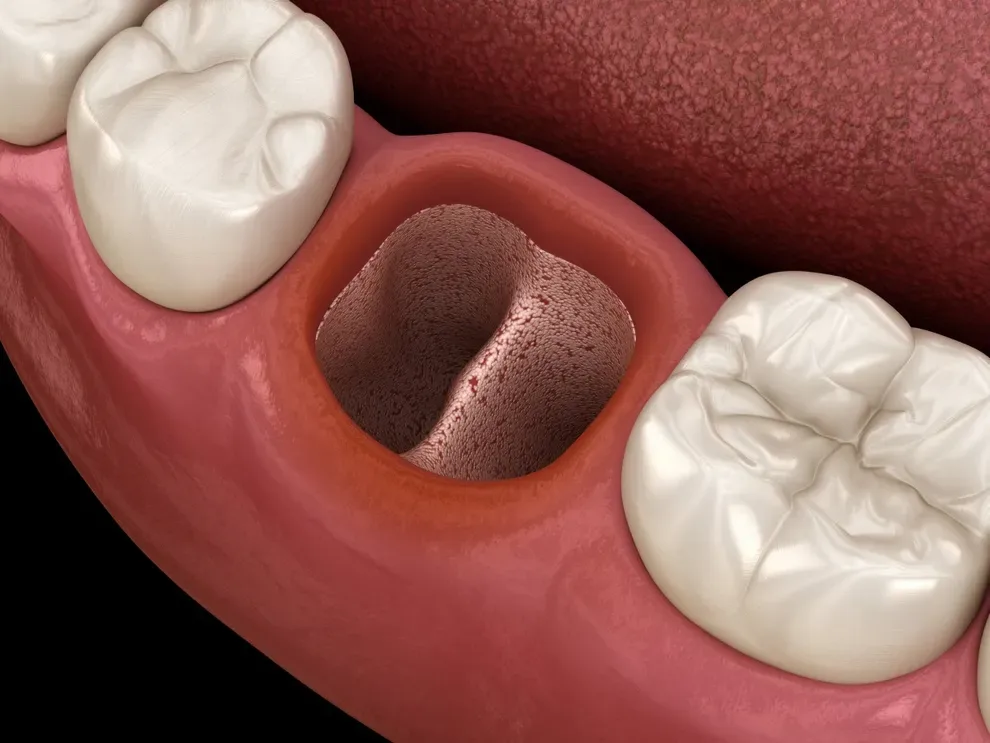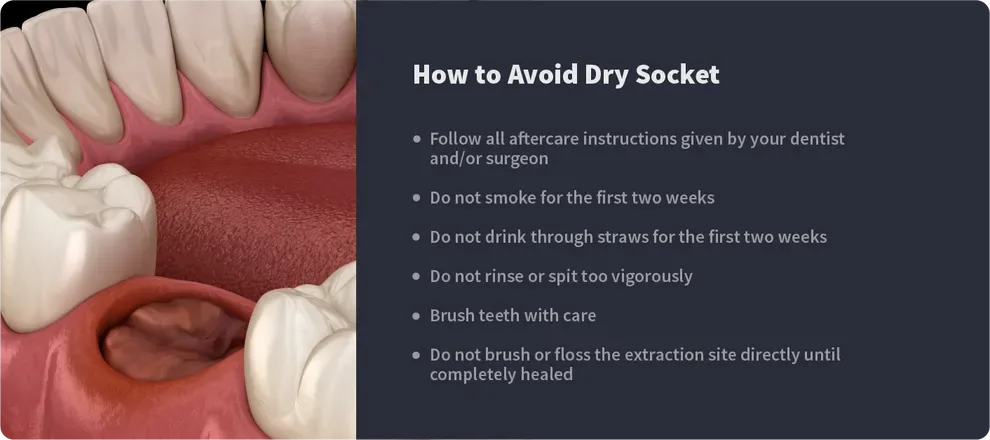Day-by-Day Expectations After a Tooth Extraction (Timeline)

Table of Contents
- Why are Extractions Need?
- What to Expect
- Importance of Aftercare
- Recovery Timeline
- How to Avoid Dry Socket
- Tips for Recovery
- References
Having your tooth extracted (sometimes called having your tooth “pulled”) can result in some bleeding and pain for the first one or two days after the procedure. The pain should significantly lessen within three days, and the extraction site should be completely healed in about two weeks.
Wisdom teeth and more complicated extractions may take longer to heal.
Why are Tooth Extractions Needed?
Generally, a dentist will try to save natural teeth when possible. But there are many scenarios in which a dentist might recommend that a tooth be extracted, including tooth decay, severe damage to a tooth, and gum disease (periodontitis).
A tooth extraction is generally a relatively simple procedure. General dentists handle many extractions but may refer patients to a dental surgeon or extraction specialist for extractions that involve complex dental or oral health problems.
The most common reasons for extracting a tooth are dental cavities and periodontal (gum) disease. Other reasons for the removal of a tooth, or a tooth extraction, can include the following:1
Trauma to the bone or tooth
Overcrowding
Wisdom teeth issues
Preparing for orthodontics or dental prosthesis
Baby (primary) teeth not falling out on their own
You will need to take care with your extraction site during the healing process to minimize pain and swelling.
What to Expect in a Tooth Extraction Procedure
Before the extraction, an x-ray will be taken to see what the issues are and what needs to be done.
Depending on how deep the tooth is or the extent of the damage, the extraction can either be simple or complex. A simple extraction involves pulling a tooth that is fully visible and accessible above the gumline.
During a tooth extraction, a dentist or oral surgeon will use a local anesthetic to numb the area. For more complex extractions, general anesthesia at a hospital may be needed. You will not feel pain, but you may feel pressure.
After the tooth is removed, the dentist or surgeon will place gauze on the area to slow the bleeding. You need to leave this gauze on for 20 to 30 minutes. You will be sent home with aftercare instructions.
The Importance of Aftercare
It’s important to follow your dental specialist’s aftercare instructions.
After treatment, the dentist or surgeon will place gauze on the site after removing the tooth. You will need to keep clean gauze on the site for the first few days after the extraction before the blood clot forms. After about a week, your clot should be formed and stable.
The first 24 hours are the most important time in the recovery process. You will need to take care with your extraction site during the healing process to minimize pain and swelling. This will also help to prevent dry socket, a painful condition in which a blood clot doesn’t form or heal correctly after an extraction.
If you experience a fever, severe pain, pus coming from the extraction site, or any other alarming symptoms after your tooth extraction procedure, you should seek medical attention immediately.
Recovery Timeline after a Tooth Extraction
A simple tooth extraction site should heal within 7 to 10 days as the blood clot forms solidly over the area.2 Within two weeks or so, the entire area should be mostly healed.
Complicated extractions, where the tooth is in multiple pieces or more invasive cutting and removal are needed, can take a little longer to heal.
In general, you can expect the following as you heal:
The gauze placed by the surgeon will help to soak up some of the blood. You will be given some clean gauze to replace it as it fills up.
Leave the initial gauze on as long as the surgeon instructs to allow the blood to start clotting. Then, you will need to change it as often as it fills with blood. You will need someone to drive you home after the procedure.
You are likely to experience some pain and discomfort for the first few days after your surgery. Over-the-counter pain medications and ice can help to reduce swelling.
You may continue to bleed for the first two days after the procedure and will need to keep changing your gauze pads.
It is important not to disturb your extraction site for the first 24 hours and to get plenty of rest. Try to elevate your head as much as possible.
After about a week to 10 days, the blood clot should be formed and in place. The bleeding should be finished.
If you have stitches that need to be removed, your surgeon will remove them at this point. Dissolvable stitches will have dissolved by now.
You still need to be careful with the extraction site, sticking to mostly soft foods and using saline rinses. You can brush and floss normally. Just be careful around the extraction site.
Generally, in about two weeks, the extraction site is fully healed. Continue to brush the area carefully, so you don’t disrupt the newly formed tissue.
Your dentist will meet with you to discuss dental implants or methods for filling the gap left by the removal of the tooth.

How to Avoid Dry Socket
Dry socket is a painful condition that can be a complication of a tooth extraction.3 It happens when the blood clot does not form the way it should, or it comes loose.
A dry socket can delay healing. Since nerves and bones are exposed to the air, it can cause significant pain. To prevent a dry socket, follow all aftercare instructions given by your dentist or surgeon.
Additionally, do not smoke or drink through straws for the first week or two after your surgery. The suction caused by these actions can cause the clot to become dislodged or not form properly.
Be careful when rinsing or spitting. Do not be too vigorous.
Brush your teeth with care. Do not brush or floss the extraction site directly until it is completely healed.
Recovery Tips
After a tooth extraction, you can promote healing by following the aftercare information given to you by your surgical team. Here are some additional aftercare and recovery tips: Stick to soft and nutritious foods for at least the first several days.
Avoid hot liquids.
Try not to blow your nose or sneeze vigorously for the first few days, as the clot is setting.
As the site heals, you can add solid foods back in. Try to eat on the opposite side of your mouth from the extraction site, and stay away from overly crunchy foods.
After the first day, brush and floss twice per day. Avoid the extraction site directly initially.
Do not smoke or use a straw.
Starting the third or so day after your surgery, you can rinse carefully with warm saltwater every few hours. This will help to both control pain and keep the mouth and site clean.
Stay away from mouthwash containing alcohol or alcoholic beverages until the site is healed completely.
Use over-the-counter pain relievers as needed. Contact your dentist if the pain continues beyond the first week or seems to get worse.
Use cold compresses and ice packs on the outside of your face for the first few days to reduce swelling.
Get plenty of rest. Try to sleep with your head elevated for the first few days.
Be sure to follow all aftercare instructions and attend follow-up care appointments with your dentist and/or oral surgeon.
